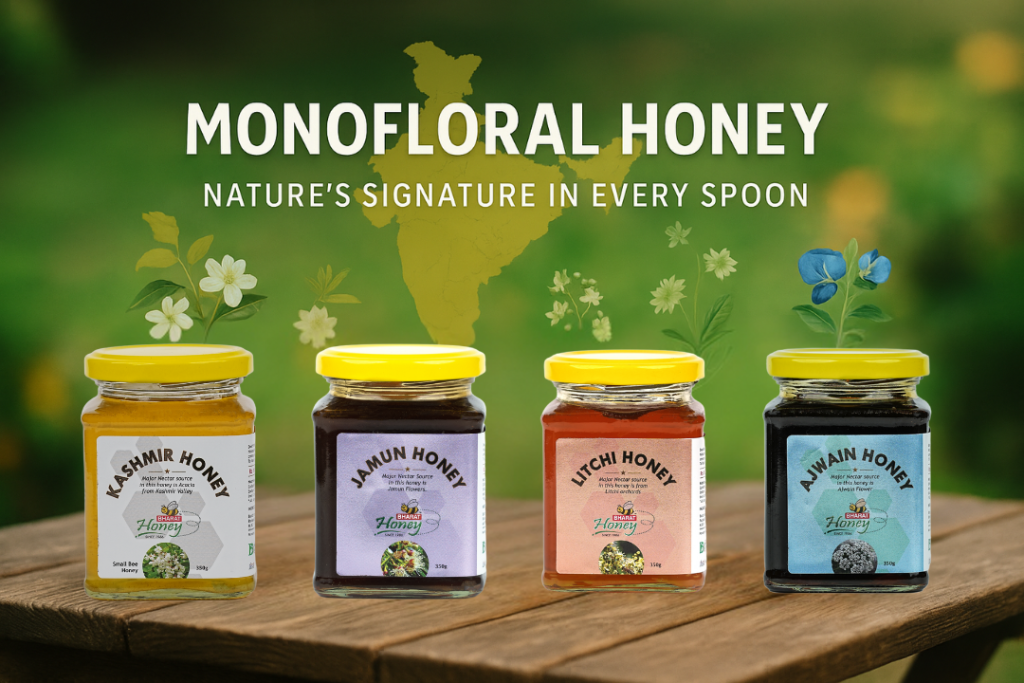What Is Mono-Floral Honey?
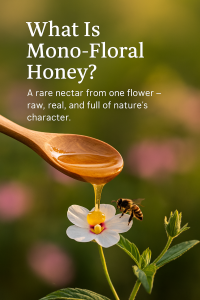
Monofloral honey, also known as single-origin honey or single-flower honey, is a unique type of honey made when bees collect nectar predominantly from one type of flower. The result? A honey that reflects the distinct taste, aroma, and color of its floral source. Each variety offers a different experience, making monofloral honey a truly extraordinary natural product for those who appreciate authenticity and diversity.
How Mono-Floral Honey is Produced
Beekeepers play a vital role in the production of monofloral honey. They migrate their bee boxes to areas that are rich in a particular flower during its peak flowering season. Since bees usually fly within a 2 km radius from their hive, if over 50% of the flowers in that area are of the same type, the resulting honey is classified as monofloral.
This careful placement and timing allow bees to collect nectar from mostly one floral source, giving the honey its signature taste and identity.
Monofloral vs. Multifloral Honey
| Feature | Monofloral Honey | Multifloral Honey |
|---|---|---|
| Floral Source | Predominantly one flower (>50%) | Multiple flower types |
| Distinctive Aroma | Yes | Varies, less distinct |
| Taste | Unique to floral source | Mixed and balanced |
| Lab Verification | Yes (pollen >45% from one flower) | No single flower dominates |
FSSAI Guidelines for Monofloral Honey
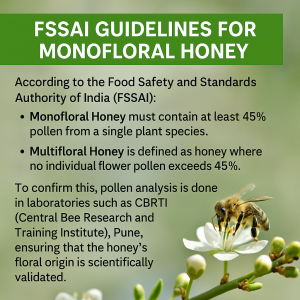
According to the Food Safety and Standards Authority of India (FSSAI):
- Monofloral Honey must contain at least 45% pollen from a single plant species.
- Multifloral Honey is defined as honey where no individual flower pollen exceeds 45%.
To confirm this, pollen analysis is done in laboratories such as CBRTI (Central Bee Research and Training Institute), Pune, ensuring that the honey’s floral origin is scientifically validated.
Why Mono-Floral Honey is Unique
Each variety of monofloral honey carries its own flavor profile, aroma, and color, depending on the flower bees forage on. Here are some examples:
| Honey Variety | Floral Source | Color | Taste & Aroma |
| Jamun Honey | Jamun Flowers | Dark | Strong & Rich |
| Acacia Honey | Acacia Flowers | Light | Mild & Delicate |
| Sidr Honey | Wild Jujube Flowers | Rich Amber | Robust & Flavorful |
| Sesame Honey | Sesame Flowers | Light Golden | Delicate & Aromatic |
Don’t Confuse Monofloral Honey with Infused Honey
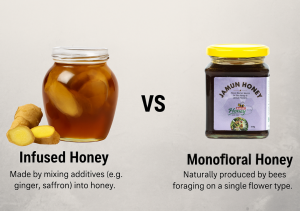
A common misconception is mixing up monofloral honey with infused honey.
- Infused Honey: Made by mixing additives (e.g., ginger, saffron) into honey.
- Monofloral Honey: Naturally produced by bees foraging on a single flower type.
For example, Ginger Honey is infused, while Jamun Honey is natural monofloral honey collected by bees from Jamun flower nectar.
FAQ: How Can Bees Collect From Only One Flower Type?
Bees typically fly within a 2 km radius. If over half the flowers in that area are of one kind, bees naturally collect more nectar from those flowers. Even if some nectar comes from other flowers, the dominant source gives the honey its name, color, and taste.
Beware of Fake Monofloral Honey Claims
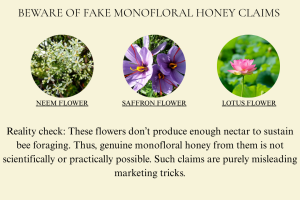
Some brands falsely market honeys like Neem, Saffron, or Lotus Honey as monofloral.
Reality check: These flowers don’t produce enough nectar to sustain bee foraging. Thus, genuine monofloral honey from them is not scientifically or practically possible. Such claims are purely misleading marketing tricks.
At Bharat Honey, we have been sourcing monofloral honey for over two decades. If such honeys were truly possible, we would have sourced and offered them long ago.
Why Raw Matters in Monofloral Honey
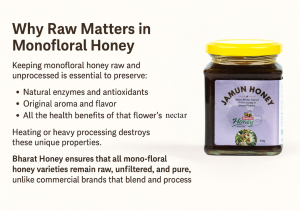
Keeping monofloral honey raw and unprocessed is essential to preserve:
- Natural enzymes and antioxidants
- Original aroma and flavor
- All the health benefits of that flower’s nectar
Heating or heavy processing destroys these unique properties.
Bharat Honey ensures that all mono-floral honey varieties remain raw, unfiltered, and pure, unlike commercial brands that blend and process.
Why Nature Thrives on Floral Variety
Just as there are many types of mangoes, nature offers different floral varieties for bees to forage on. This biodiversity benefits both:
- Agriculture through effective pollination
- Ecology by maintaining floral cycles and balance
Each monofloral honey reflects this natural richness, offering a different taste and health benefit you can’t replicate synthetically.
Bharat Honey’s Trusted Monofloral Varieties
Here’s a taste of India’s floral diversity through our carefully sourced mono-floral honeys:
- Jamun Honey – Dark and robust; supports blood sugar balance. [Discover More]
- Acacia Honey (Kashmir) – Light and delicate; a soft, floral sweetness. [Discover More]
- Sidr Honey (Wild Jujube) – Amber-toned with rich flavor; strong antioxidant properties. [Discover More]
- Ajwain Honey – Strong aroma and spicy aftertaste; excellent for digestion. [Discover More]
- Eucalyptus Honey – Bold aroma and taste; helpful for respiratory health. [Discover More]
- Litchi Honey – Light and fruity; popular for its floral flavor. [Discover More]
- Sesame Honey – From Gujarat; light and immune-boosting. [Discover More]
- Coriander Honey – Digestive benefits with mild herbal notes. [Discover More]
- Fennel Honey – Light and sweet; calming for the digestive system. [Discover More]
- Jammu Honey (Bansa & Kadipatta) – Light and aromatic; excellent for immunity. [Discover More]
- Clover Honey – Smooth and sweet; known for energy-boosting benefits. [Discover More]
Conclusion: Nature’s Finest in Every Spoon
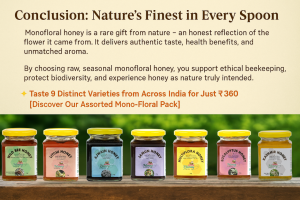
Monofloral honey is a rare gift from nature – an honest reflection of the flower it came from. It delivers authentic taste, health benefits, and unmatched aroma.
By choosing raw, seasonal monofloral honey, you support ethical beekeeping, protect biodiversity, and experience honey as nature truly intended.

